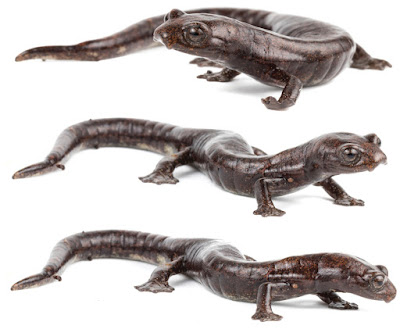 |
| Bolitoglossa muisca López-Perilla, Fernández-Roldán, Meza-Joya et Medina-Rangel, 2023 |
Abstract
A new salamander species of the genus Bolitoglossa is here described from the cloud forests of the western slopes of the Cordillera Oriental of Colombia, in the Cundinamarca department. The most salient characters of this new species are its numerous maxillary and vomerine teeth, its moderate webbing on hands and feet, its short and robust tail, and its chromatic variation. Based on molecular analyses this new species is assigned to the adspersa species group and its status established as the sister species of B. adspersa, with which it was previously confused. Lastly, the distribution, natural history, and conservation status of the new species are discussed.
Keywords: Biodiversity, coloration, phylogenetic systematics, salamanders, taxonomy
 |
| Paratype of Bolitoglossa muisca (IAvH-Am-17419) in life. Photographs by Juan David Fernández-Roldán. |
 |
| Chromatic variation of Bolitoglossa muisca in life. Notice some individuals bear white blotches on the ventral surfaces of the body and the tail. Photographs by Yeny Rocio López-Perilla. |
Bolitoglossa muisca sp. nov.
Common English name: Muisca salamander
Common Spanish name: Salamandra Muisca
Diagnosis: Bolitoglossa muisca is a member the subgenus Eladinea and of the adspersa species group. The new species is characterized by the following morphological characters: a large-size body; a broad head; a rounded snout in dorsal and ventral views; a very thick postocular fold; a moderate subgular fold; smooth skin texture; moderately long limbs; moderate webbing on third finger and toe; and a short, robust tail.
...
Etymology: Named after the native human inhabitants of the Altiplano Cundiboyacense and Sabana de Bogotá. The Muiscas regarded amphibians as sacred creatures associated with sex, fertility, and the arrival of the rainy season. The specific epithet is used as a noun in apposition.
Yeny Rocio López-Perilla, Juan David Fernández-Roldán, Fabio Leonardo Meza-Joya nd Guido Fabian Medina-Rangel. 2023. A New Bolitoglossa (Amphibia, Caudata, Plethodontidae) from the Cordillera Oriental of Colombia. ZooKeys 1158: 27-48. DOI: 10.3897/zookeys.1158.99077
Resumen: Describimos una nueva especie de salamandra del género Bolitoglossa proveniente de los bosques nublados de la vertiente occidental de la Cordillera Oriental de Colombia, en el departamento de Cundinamarca. Los caracteres más sobresalientes de esta nueva especie son sus numerosos dientes maxilares y vomerinos, su palmeadura moderada en pies y manos, su cola corta pero robusta, y su variación cromática. Basados en análisis moleculares asignamos esta nueva especie al grupo de especies adspersa y establecemos su estatus como especie hermana de B. adspersa, con la cual era previamente confundida. Finalmente, discutimos algunos aspectos de su distribución, historia natural y su estado de conservación.
Palabras clave: Biodiversidad, coloración, salamandras, sistemática filogenética, taxonomía
